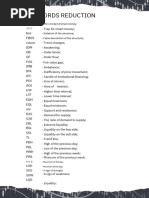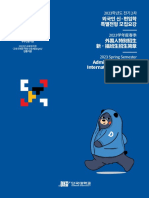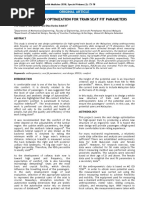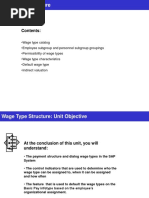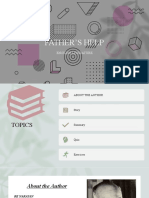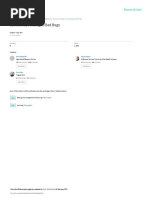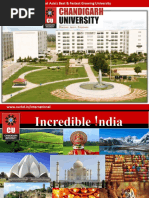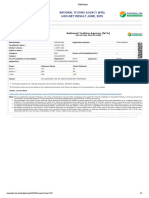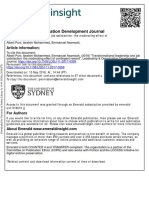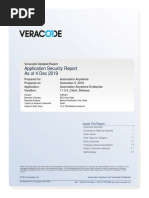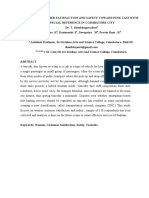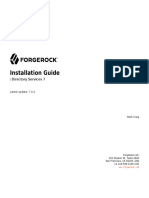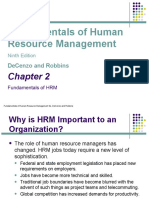Human Resource Accounting: An Implication For Managerial Decisions in Indian Hotel Industry
Human Resource Accounting: An Implication For Managerial Decisions in Indian Hotel Industry
Uploaded by
NEXT LEVEL BASSCopyright:
Available Formats
Human Resource Accounting: An Implication For Managerial Decisions in Indian Hotel Industry
Human Resource Accounting: An Implication For Managerial Decisions in Indian Hotel Industry
Uploaded by
NEXT LEVEL BASSOriginal Title
Copyright
Available Formats
Share this document
Did you find this document useful?
Is this content inappropriate?
Copyright:
Available Formats
Human Resource Accounting: An Implication For Managerial Decisions in Indian Hotel Industry
Human Resource Accounting: An Implication For Managerial Decisions in Indian Hotel Industry
Uploaded by
NEXT LEVEL BASSCopyright:
Available Formats
©International Journal of Hospitality & Tourism Systems Volume 1 Issue 1 2008
Human Resource Accounting: an Implication for
Managerial Decisions in Indian Hotel Industry
Mohinder Chand
Associate Professor, Department of Tourism and Hotel Management, Kurukshetra University
Heera Lal
Senior Lecturer, BPR College, Kurukshetra (HR)
Abstract:- and tourism (74.2) is higher as compare to
agriculture (49.7), railway (0.9) and manufacturing
Hotel and tourism, with its immense employment
(15.7). Further, employment-output ratio is also
generation capability is very often called ‘people
higher in hotel and tourism (75), then textile (27),
intensive industry’. In this industry, human
leather (51) and electricity (14), (2007).
resources constitute a higher element of total
operating cost. Obviously, the effective and
Hotel industry in India, with its immense forex
extensive Human Resource Management (HRM) is
earnings; employment generation and enormous
critically significant to control the operating cost
multifarious advantages, is currently one of the
for long run survival. The Human Resource
most competitive industries. It is also becoming
Policies and practices of every hotel company will
increasingly global with many hotel companies
have direct impact on procurement costs, quality
operating at International scale like the Taj Group
human resources, delivery of quality products \
of Hotels, ITDC’s Ashok Group of hotels,
services and reduce employees turnover. Therefore,
Welcomgroup of hotels; and the Oberoi Group of
management needs to ensure that HR activities
Hotels etc. The direct employment in the hotel
should add value to the business. Today, managers
sector has increased from 5.54 million in 1991-92
are increasingly being asked to justify their
to 14.25 million in 2002-2003 and has touched 16.5
decisions in financial terms. This development has
million by the year 2007.
proven to be especially difficult for HR managers
as their activities are usually evaluated in
Moreover, hospitality industry with its immense
behavioural /statistical terms rather than financial
employment generation capability is very often
ones. In this paper the endeavour is primarily to
called ‘people intensive industry’. In this industry,
examine the extent to which hotel companies can,
human resources constitute a higher element of
and do measure the value of their human resources
total operating cost. Obviously, the effective and
in financial terms. It also focuses on to promote an
extensive Human Resource Management (HRM) is
understanding and significant of HRA information
critically significant to control the operating cost
for making vital Human Resource decisions in
for long run survival. The Human Resource
hotel companies in India.
Policies and practices of every hotel company will
Key Words: human resource accounting, hotel have direct impact on procurement costs, quality
industry, human resource management human resources, delivery of quality products \
services and reduce employees turnover. Therefore,
management needs to ensure that HR activities
should add value to the business.
Today, tourism and hospitality is World’s largest
Industry and generates more than 12% of global
Today, managers are increasingly being asked to
GDP. It has emerged as a dominant economic giant justify their decisions in financial terms. This
on the global scene, accounting for more than 10% development has proven to be especially difficult
of the World trade and growing at the rate of 6.5%
for HR managers as their activities are usually
annually. The tremendous pace of development in evaluated in behavioural/statistical terms rather
this industry is further evident from the fact that it than financial ones.
is a major employer, has created 255 million and
450 million jobs in 2000, and 2003, is likely to In this paper the endeavour is primarily to examine
touch 538 million and 685 million by the years
the extent to which hotel companies can, and do
2005 and 2006 respectively (2007). The labour- measure the value of their human resources in
capital ratio per million rupees invested in hotel
Online access @ www.publishingindia.com 65
©International Journal of Hospitality & Tourism Systems Volume 1 Issue 1 2008
financial terms. It also focuses on to promote an be treated as an asset. But the actual fact is that, it
understanding and significant of HRA information is the investment in human resources and not the
for making vital Human Resource decisions in personnel themselves. Thus, there should not be
hotel companies in India. any objection to treat human resources as an ‘asset’
and put the value in the position statement. Despite
REVIEW OF LITERATURE the some controversy outlined above, the Human
Managing human resources in an organization is Resource Accounting (HRA), literature does offer
one of the key elements of management (Mohinder, more useful and practical advice for determines the
2004). Whatever means are used to ensure the costs and values of this important ‘Asset’.
creation and delivery of services & goods in (Kiesoetal, 2003; Charaborty ,1976 and Arden
modern economic world, the role of individuals and ,1974)
groups as employees and the ability of management
to effectively deploy such resources is vital in the A hotel company invests huge time and money in
interest of both employee and employer alike. In human asset and effective & efficient use of this
hotel industry management has recognised that it is asset is depends upon human resource information
the human element of service product that provides system (Mohinder and Anastasia, 2007). The
the key competitive advantage in the market place technique which is used to identify, measure and
(Anastassova and Purcell, 1995). Therefore, human reports about human resources is known as Human
resources are managed with utmost care, Resource Accounting’. Measuring the financial
accountability and rationality as other resources worth of human resources is not a new
like, plant, building, machinery and finance etc. of phenomenon, but it dates back in 1691’s. It was
the organisation. Unfortunately, employees turn William Petty, (1691) who has made the first
over is very higher in lodging industry in attempt to value the people in financial terms. He
comparison to other industries. It indicates as was of the opinion that employee is the father of
symptomatic of poor HRM systems and practices wealth and this must be taken into consideration
in this industry. The inputs of hotel industry are while making an estimate of wealth. The various
human beings and outputs are also human behavioural scientists in this field further made
resources. Therefore, hotel manpower must gear efforts to confine the term. However, the real work
itself to play more efficient and responsible role to was started from 1960’s. Rensis Likert (1961), an
meet the expectations of the International tourism. American sociologist, has originally popularised
The standard of services in this industry is always the concept ‘Human Asset Accounting’. He has
measured with International pattern. Obviously, emphasized the need of HRA as a tool for
human resources are most important asset of this Managerial decisions. Elias (1970) opined that the
International Industry. (Now question is why decisions based on Financial Accounting
people called as an ‘Asset’? Information are quite different from those based on
human resources accounting. Arden (1974)
Here, it becomes imperative to define human perceived that HRA data are more important for
resources as ‘an asset’. The exact definition of an evaluating stock investment decision concerning
asset is that it must possess future service potential, organization with higher percentage of Managers,
measurable in monetary terms and owned by the administrator, professionals and technical workers
owner. There are some thinkers who refuse to treat than the decision concerning with lower percentage
human resources as an ‘asset’. According to them of these workers. Charles (1974) the major function
HRs can not be disposed off or converted into cash. of HRM is the recruitment and retention of quality
However, it is only a technical ground that the employees, which is largely based on the type of
members of the staff are free to leave more or less information provided to the decision-makers.
at their will, the organization will replace them by
others and thus the staff strength will more or less Many scholars have stated the need for more
be maintained. Another opinion is that human corporate financial transparency, and concerns that
resources do not give any assurance and do not the omission of the value of human, structural and
have stored value like other assets e.g. building, intellectual capital as organization assets results in
machinery, and furniture etc. an under-valuation of the knowledge based
companies that drive the new economy (Grojer,
However, this criterion of not treating human 1997; Olsson, 1999, 2001a, b, 2003; and Kiesoetal,
resources as an asset seems to carry no weight 2003). Further, it is argued that organizations
(Charles, 1974). In this world nothing is certain and acquire HR to generate future revenues, and
no asset can give future assurance and stored valve. therefore HR should be considered when valuing a
Even the debtors, bills receivable and other similar company by capitalizing instead of expensing them
securities are not sure to be realized. Further, in the current period (Flamholtz, 1995, 1999;
accountants argue that human resources are not Gröjer, 1997 and Mohinder, 1991). Thus, The crux
owned by an organization and, hence they cannot of the argument is that human, intellectual, and
Online access @ www.publishingindia.com 66
©International Journal of Hospitality & Tourism Systems Volume 1 Issue 1 2008
structural capital should be treated in the same way ACCOUNTING for HUMAN ASSET —
as the things they are like; the things these Theoretical Perspective
advocates think they are most like are assets, and During the last two decades number of
since assets are reported on the balance sheet, these approaches has been developed to measure the cost
also should be reported along with the physical and value of human resources in the organisation.
assets (Cascio, 2000 and Schmidt et al., 1979). The brief discussion of these is as:
There are many experts who have suggested Historical Cost: Human resources are valued at
methods \ models to determine the value of human the unexpired portion of the costs of recruiting,
resources in an organisation, such as Flamholtz selecting, hiring, training, familiarization and
,1971, 1972 , 1975; Mores ,1973; Organ Pickin development of employees of an organization.
,1974; Lawrence ,1975; Jaggi and Lev ,1974; N. Moreover, the unexpired value is shown as an
Das Gupta ,1978; Jackson Floyat ,1978; S.K. investment in human asset. This method is very
Charaborty ,1976), and Fry Elaine hobbs ,1978) simple and meets the tests of traditional
etc. But due to the practical utility of these methods Accounting Principle ‘Matching costs with
and models; interest in exploring this vital field of revenue’. However, the management need human
accounting has declined in the early 1980’s. Infect, resource information about the present and the
organisations at that time have focused attention on future like what is the value/cost of human resource
labour as cost to be minimized. Obviously, today and how are these costs/values changing.
method/models of HRA seemed to have limited This approach does not fulfil these requirements.
significance for managerial decisions.
Business environment is changing rapidly in the Replacement Cost: This method suggested and
1990’s. Moreover, in the wake of liberalisation and developed by Rensis Likert and G. Flamholtz. It
globalisation of Indian economy, the hotel industry estimates the cost of replacing the existing
is getting gradually internationalised and has employees under existing organizational
stressed the need and importance to develop conditions. Human resources of an organization are
meaningful methods/techniques for evaluating the to be valued on the assumption that a new similar
contribution of human resources in an organization. organization is to be created from scratch and then
Practically, the following facts have increased the estimates the cost required for this purpose. It takes
need of accurate, timely, reliable and into consideration the fluctuations in jobs and
understandable HR information for managerial general rise in price level in the market. Obviously,
decisions in hotel industry: - this method incorporates the current value of
Development of Modern Organisation Theory company’s HRs. However, it is very difficult to
Traditional Framework of Accounting has find identical replacement cost of the existing
Changed personnel in actual practice. Further, the
Technology determinations of a value/cost will be affected by
Development of Neo-human Relations the subjective considerations to a marked extend
Philosophy of People Management and different managers/accountants may arrive at
Development of modern management tools quite different estimates.
RESEARCH METHODOLOGY Opportunity Cost: According to Hekimian and
Numerous studies have suggested the implication Jones the human resource values/costs are
of “Human Resource Accounting” in organizations. measured through a competitive bidding process
The conceptual framework presented in this article within the company known as opportunity cost. It
has drawn on literature from Human Resource is the value of an asset when there is an alternative
Accounting, Human Resource Management, use of it. The investment centre managers will bid
Management Theory, and Strategic Management. for the scarce employees they need to recruit. The
These fields of study were identified through a employees who are not considered scarce are not
search of scholarly literature available primarily included in the value of HRs of the organization.
through electronic databases. The initial review of This approach provides more optimal allocation of
literature began with an examination of personnel and sets the quantitative base for
publications that discussed the concept of Human decisions regarding development of human asset.
Resource Accounting and how this concept existed However, this method results in lowering the
within organizations. The review process was then morale and productivity of the human resources
narrowed down to publications that referred who were not covered in bidding process. Further,
specifically to the movement of managing human practically this approach provides inadequate
resources within organizations. The conclusion information for managerial decisions.
provides a discussion of implications for theory
building and for practice in the hotel industry. Present Value of Future Earning Model: Under
this model, the value of human resources is
Online access @ www.publishingindia.com 67
©International Journal of Hospitality & Tourism Systems Volume 1 Issue 1 2008
calculated as firstly; divide all personnel into employment. The determined value should be
homogeneous group according to their age and adjusted t the end of each year on the basis of
skill. Secondly, determine average Annual individual age, seniority, status, experience,
Earnings. Thirdly, Calculate total earning of each managerial abilities and performance etc. This
group up to retirement age, and fourthly use the model considers both human resources who are
cost of capital rate for capitalizing the present value employed and unemployed. It seems to be sound
of the future earnings of the employees. In other theoretically. However, its practical utility is very
words, the model involves valuation of ‘Human difficult because it is based on certain factors,
Assets’ on the bases of the present value of the which may not be expressed in monetary terms
estimated future earnings of the employees precisely and objectively.
discounted at the cost of capital rate. This basis of Besides the above discussed methods, many
valuation of HRs is quite complicated and more models have also been sued like Net Benefit
overstates an employee’s expected service life and Model and Certainly Equivalent Net Benefit
his future earning. Moreover, salaries paid to Model. These are based on net benefit received by
personnel may not really represent the human the organisation from the services of its employees.
resource(s) a real worth to the organization. In other words the value of human resources is
equivalent to the present value of net benefits
Stochastic Reward Valuation Model: This model received by the organisation from the service of its
is based on estimated expected future services and employees. The major draw back of these models is
is mainly concerned with the problem, how to the calculation of Net Benefit.
determine the value of an individual to an A critical analysis of the models/methods of
organization. An individual value to an human resource valuation has revealed that the
organization is his expected realizable value. It is HRA deals with number of variables that are very
estimated on the basis of the present worth of the difficult to measure in financial terms. Discussion
set of future services he is expected to provide has also pointed out that these models based on
during the period he is likely to stay with the unrealistic assumptions and no one method/model
organization. Theoretically, this is the best model is both objective and meaningful. However, the
as it estimates, ‘the present value of expected future present value of future earning model has found
services and considers human resources as ‘an suitable on account of convenience and objectively.
asset’. However, it is quite complicated to obtain Further, it made clear that there is dire need to
realizable value, as it requires detailed manpower develop an appropriate model that should be based
planning which is not feasible. on both objective and subjective valuation of
human asset and should provide a meaningful
Aggregate Payment Model: This model considers information, which assist management in decision-
the human resources of an organization as a group making.
rather than individual and determines the values/
costs on this basis. However, Managerial and Non- Importance of HRA Information in Hotel
Managerial personnel can be valuated separately. Companies
The value of HRs is determined by multiplying the In India, the hotel companies are require to
average salary of the group with the average tenure prepare and present their financial statements
of the employees of that group and discounted at (profit and loss account and balance sheet) as per
the expected average (after tax) return on capital the provision of the companies Act, 1956. The
employed over the average tenure period to section 211 (2) and 211 (1) of the companies Act,
ascertain the present value of the estimated future 1956 require that the profit and loss account and
payments. This method records the recruitment, balance sheet of every hotel company shall be
hiring, selection, development and training costs prepared and presented with the requirements and
separately and treated as deferred revenue Performa given in the part II of schedule VI and
expenditure. This method suggests that human part I schedule VI respectively. Incidentally, the
resources should be shown under the head Act does not provide for disclosure of any
investments in the balance sheet. significant information of human resources
Total Cost Approach: The total cost approach is employed in a hotel company except that the
different from all the method suggested by various companies have to give by way of a note to the
scholars. Under this approach human resource profit and loss account, particulars of employees
value to an organisation is equal to total cost getting remuneration of Rs. 1, 44,000 per annum or
incurred by the individual, state and the more. However, there is nothing in the companies
organisation in bringing individual up to that Act that prevents hotel companies from giving
position or making him fit for appropriate details about its ‘Human Assets’ by way of a
employment in the organisation. In other words, supplementary information attached with its
cost of human asset is equal to cost of formal financial statements.
education and training plus cost of post
Online access @ www.publishingindia.com 68
©International Journal of Hospitality & Tourism Systems Volume 1 Issue 1 2008
If we look at the annual reports of hotel companies investment in recruitment, selection, hiring,
in India like Indian Hotels Co. Ltd., East India training and development of employees is
Hotels Co. Ltd., Bharat Hotels Co.Ltd. and many significant in these companies. According to
more Etc. we find that chairman’s report invariably Hopwood (1973), “Accounting system provide
contains the statements highlighting the most important information which is intended to
significance of human resources. The Chairman of assist managers make decisions which are in
these companies makes their remarks that our agreement with their organisation goals.”
employees are out most important assets and Hospitality management has been making decisions
without their significant contribution; the present that directly/indirectly effect on organisation’s
growth in the operation would not have been human resources. HRA is a tool for evaluating
attained. These qualitative pronouncements reflect change in the human assets and provides
the role and importance of human asset in an information to management for decision making
organisation. But unfortunately the quantitative regarding recruitment, hiring, promotion, training,
information to their value has not been shown in transfer, retrenchment, planning of physical assets
the financial statements till today. However, in vis-à-vis human assets. It evaluates the
practice, a few enterprises both public and private expenditures incurred for imparting further
sector in India value their human resources in education & training to employees in terms of the
financial terms and incorporate this vital benefits drive by the company. Moreover, Human
information in their annual reports. Resource Accounting helps in identifying the
causes of high labour turnover, and locating the
The International Accounting Standard Committee real cause of low return on investment, whether due
(IASC) was established in 1973 to formulate to improper or under utilisation of physical assets
Accounting Standards and to promote their or human assets or both. According to Likert
worldwide acceptance and observance. The ,1967), “Managers decisions may range from those
committee has so for published 30 International which are directly attempt to enhance the value of
Accounting Standards. On the other hand the the firms’ human resources to those which
council of the Institute of Chartered Accountants of systematically liquidate them in order to show
India (ICAI) has constituted the Accounting greater short run profits. In any case these
Standards Board (ASB) in 1977, to formulate conditions are not recalled by the financial
accounting standards for the companies operating accounting reports.” Robert Wright, 1977) has
in India. The ICAI is the member of IASC and stated that, “the ratio of investment in human assets
gives due consideration to International Accounting to total assets is an indicator of profitability of
Standards. Although the IASC and ICAI have generating future profits. If human assets ratio is
brought out (30 and 15) accounting Standards on higher there will be the higher profitability and if
most of the technical areas in accounting and have lower then lower profitability”. It implies that HRA
ensured their implementation by making them is helpful for potential investors and other users in
mandatory. Regretting, both the IASC and ICAI making long-term investment decisions.
have not been able to bring any definite accounting
standard for measuring ‘Human Resource’ DEVELOPING HRA SYSTEM for HOTEL
cost/value to report in the financial statements. INDUSTRY
However, the existing accounting standards fully We have described different methods \ models
support the adoption of HRA for the purpose of which could be used to determine value/cost of
meeting their own requirements in true sense human resources in hotel companies. But the
(2005). reasoning behind this is whether to introduce HRA
system in hotel industry and which method(s) to
Accounting is in an age of rapid transition, its apply-will require a considerable amount of
environment has undergone to vast changes during professional judgment. In order to evaluate the
the last two decades and increasingly complex practical implications of developing HRA system
business environment requires increased in a hotel company, let us discuss the process of
investment by companies in human resources. This designing and implementation of HRA system in
requirement is more intense in hotel companies as hotel industry.
Online access @ www.publishingindia.com 69
©International Journal of Hospitality & Tourism Systems Volume 1 Issue 1 2008
Fig 1: Process of Developing HRA System in Hotel Industry
HRM Objectives/Goals of HRM
Polices and Practices of HRM
HR Information Requirements
Identify and Define HRA Objective and Scope
Need and significance of HRA
Develop HRA Measurements
Select Method/Model
Test the Reliability and Validity
Implement HRA System
Apply Model/Method
Modify If Required
Analyse Results
Provide HRs Information to Mgt.
Size and Structure of Organisation;
Organisation Climate;
Fig. 1 shows design and development process of Top Management Support;
HRA system in hotel industry, it depicts four Substantial Commitment of Time & Efforts;
phases process which identifies the need and and
significance of HRA information for managerial Employees Co-operation
decisions. Human resource management is defined
as the process of developing people and lays claim Despite number of factors affecting on HRA
to the achievement of organisation objectives. To system in hotel industry, HRA will provide
assist HRM in fulfilling this major task, the valuable information about human resources for
accountants should provide appropriate human inclusion in the corporate reports. Moreover, HRA
resource accounting information for decision will definitely be a power full tool in the hands of
making and inclusion in corporate report. The management to solve many employees’ problems
accountants should identify the objectives and in the knowledge economy.
scope of human resource accounting before
developing the measurement. This analysis refers
to the selection of the models/methods and than test CONCLUSION and IMPLICATIONS
the reliability and validity. The testing should be The hotel companies invest huge amount and time
focused on a few factors/variables that appear to be in human asset. Therefore, effective and extensive
critically important. Finally, the implementation of use of this important asset is obviously vital for
an HRA system should not be undertaken even it is long term survival of the hotel organisations.
acceptable, unless there are reasonable expectations Unfortunately, financial accounting fails to
that it will yield useful results over a period of incorporate the value/cost of ‘human asset’ in the
time. Muscove (1983) “A well-developed HRA annual reports, although the contribution and
system can theoretically aid managers in becoming importance of human resources are often
more effective and efficient in managing the human acknowledged in the Chairman’s report.
resources that are available to them”. Moreover, Incidentally, in the recent years this trend has
one of the major functions of HRM is the changed and necessity of accounting for human
recruitment and retention of quality employees and resources has been increasingly realised. Today,
to increase its stock of human capital. HRA is recognised as a powerful managerial tool
Development of an HRA system in Hotel industry for proper management of human resources. It
is based on following factors/variables: - helps in developing such type of employment
opportunities which can give higher rate of return
on human capital, helps management to make more
Online access @ www.publishingindia.com 70
©International Journal of Hospitality & Tourism Systems Volume 1 Issue 1 2008
informal decisions regarding HRs, and suggests Ferguson And Bergar (1985) Employees As Assets:
measures to determine the cost and value of human A Fresh Approach to HRA, The Council of HRA
assets in the organisation. It established economic Quarterly 25.
relationship between education and employment. It
also helps in creating a feeling of social Flamholtz, E.G. (1985) Human Resource
responsibility among individuals, which is the key Accounting: Advances in Concepts, Methods and
to prosperity of any society or Nation. The present Applications, Jossey-Bass, San Francisco, CA,
work has not included an attempt to construct an
HRA model. The focus has been on illustrating the Flamholtz, E.G. (1999) Human Resource
significance of human resource data for making Accounting – Advances in Concepts, Methods and
effective managerial decisions in hotel companies Applications, Kluwer Academic, Boston, MA,
rather than evaluating the relevant views and
propositions. The explanatory comments have been Flamholtz, Eric G. (1985) Human Resource
designed to promote the understanding rather than Accounting: Advances in Concepts, Methods and
to advocate the acceptance of HRA in hotel Applications, Jassey-Bass Publishers, London.
companies in India.
Gröjer, J.-E. (1997) Employee artifacts on the
REFERENCES balance sheet: a model illustration and
Anastassova ,L.,and Purcell,K.(1995) Human implications, Journal of Human Resource Costing
resource management in the Bulgarian hotel & Accounting, Vol. 2 No.1, pp.27-53.
industry: fromcommand to empowerment,
International Journal of Hospitality Hermanson, R.H. (1964) Accounting for human
Management,Vol.14 No.2. pp. 171-85. assets, Occasional Paper, No. 14, Graduate School
of Business Administration, East Lansing, MI,
Boudreau, J.W., Rynes, S.L. (1985) Role of
recruitment in staffing utility analysis, Journal of Hopwood, Anthony G., (1972) An Empirical Study
Applied Psychology, Vol. 70 pp.354-66. of The Role of Accounting Data In Performance
Evaluation, Journal of Accounting Research 10.
Brummet, R.L., Flamholtz, E., Pyle, W.C. (1968a)
Accounting for human resources, Michigan Hopwood, Anthony G., (1973) Problems with
Business Review, Vol. 20 No.2, pp.20-5. Using Accounting Information in Performance
Evaluation, Management International Review, No.
Brummet, R.L., Flamholtz, E., Pyle, W.C. (1968b), 2-3.
Human resource measurement – a challenge for
accountants, The Accounting Review, Vol. 43 Hopwood, Anthony G., (1974) Human Asset
pp.217-24. Accounting, Administrative Staff College Henely,
London.
Brummet, R.L., Flamholtz, E., Pyle, W.C. (1969b)
Human resource myopia, Monthly Labor Review, Likert, Rensis, (1967) The Human Organisation: Its
Vol. 92 No.1, pp.29-30. Management and Value, Mcraw Hill Book
Company New York.
Brummet, R.L., Flamholtz, E., Pyle, W.C., Likert,
R. (1975), Human Resource Accounting: Maher, A., (1993) Accounting for Human
Development and Implementation in Industry, Resources in UK Hotels: Some Initial Findings,
Foundation on Human Behavior, Ann Arbor, MI. Paper Present at the Council for Hospitality
Management Education Research Conference,
Cascio, W.F. (2000) Costing Human Resources: M.M. University.
The Financial Impact of Behavior in
Organizations, 4th ed., South-Western College Mayo, A. (2004) "Measuring human capital",
Publishing, Cincinnati, OH, Worldwide Link, Vol. 14 No.2, pp.3.
Chand, Mohinder (1991) Human Resource Mohinder C. (2004) Human resource strategies and
Accounting - A Case Study of LIC Shimla global competitiveness: a study of Indian small and
Division, An Unpublished M.Phil. Dissertation, medium sized tourism enterprises, paper presented
H.P.U. at the International Conference on Creating Global
Edvinsson, L., Malone, M.S. (1997) Intellectual Competitive Advantage, Laxpara Foundation India.
Capital: Realizing Your Company's True Value by
Finding its Hidden Brainpower, HarperBusiness, Mohinder C. and Anastasia A.K., (2007) The
New York, NY, impact of HRM practices on organisational
Online access @ www.publishingindia.com 71
©International Journal of Hospitality & Tourism Systems Volume 1 Issue 1 2008
performance in the Indian hotel industry, Employee
Relations, vol.29 No.6, pp.576-94.
Muscove, S.A. (1983), A Further Investigation into
Human Resource Accounting, Journal of
Accountancy.
Scarpello, V., Theeke, H.A. (1989) "Human
resource accounting: a measured critique", Journal
of Accounting Literature, Vol. 8 pp.265-80.
The Hindu, 13th May 1998.
The Indian Institute of Chartered Accountant
(2005) Report.
The World Travel and Tourism (2005 & 2007)
Travel and Tourism’s Economic Perspective, A
Special Report, Belgium.
Times of India 26th July 1995.
Tourist Statistics (2007 Deptt. of Tourism, Ministry
of Tourism Govt. of India New Delhi.
Online access @ www.publishingindia.com 72
You might also like
- E Book Smart Money SMC - PDF - 20240605 - 172058 - 0000Document30 pagesE Book Smart Money SMC - PDF - 20240605 - 172058 - 0000bhojpuriya.lofies.11.05No ratings yet
- Needham Bank - A BYOD Case StudyDocument8 pagesNeedham Bank - A BYOD Case StudyMitzi SantosNo ratings yet
- Working To The Beat - A Self-Regulatory Framework Linking Music Characteristics To Job PerformanceDocument26 pagesWorking To The Beat - A Self-Regulatory Framework Linking Music Characteristics To Job PerformanceMarcelo PinheiroNo ratings yet
- Admission Guide DankookDocument49 pagesAdmission Guide DankookTsevelmaa TsevkaNo ratings yet
- Ergonomic Design Optimization For Train Seat Fit Parameters: Original ArticleDocument6 pagesErgonomic Design Optimization For Train Seat Fit Parameters: Original ArticlenitingahlawattNo ratings yet
- EurekaDocument17 pagesEurekaBiswarup BanerjeeNo ratings yet
- 06 Payroll WagetypeDocument31 pages06 Payroll WagetypeAnu KasaragodeNo ratings yet
- SBP-BSC Assistant Director (OG-3) Sample PaperDocument11 pagesSBP-BSC Assistant Director (OG-3) Sample Paperasstt_dir_pndNo ratings yet
- A Tight Labor Market For Cleaners and The Tough ScreenerDocument8 pagesA Tight Labor Market For Cleaners and The Tough Screenermuddasir123No ratings yet
- 8531 1uniDocument18 pages8531 1uniMs AimaNo ratings yet
- Father's HelpDocument9 pagesFather's HelpAanya BhatnagarNo ratings yet
- 61 Yogesh Kalne MMS Finance SirpDocument31 pages61 Yogesh Kalne MMS Finance SirpJignesh TamkeNo ratings yet
- Laboratory Rearing of Bed Bugs: Mark Feldlaufer Harold HarlanDocument21 pagesLaboratory Rearing of Bed Bugs: Mark Feldlaufer Harold HarlanMazhar FarNo ratings yet
- Designing Promotional Strategies For Medical Tourism in India: A Case Study of An Ophthalmic Hospital in NCRDocument10 pagesDesigning Promotional Strategies For Medical Tourism in India: A Case Study of An Ophthalmic Hospital in NCRNeeraj DaniNo ratings yet
- CUDocument45 pagesCUmotaz TamimiNo ratings yet
- N Tep Training Modules 1 To 4Document301 pagesN Tep Training Modules 1 To 4Amit A.MNo ratings yet
- Ugc-Net Result June, 2019: National Testing Agency (Nta)Document1 pageUgc-Net Result June, 2019: National Testing Agency (Nta)UJJWAL100% (1)
- 2 Instruction SetDocument140 pages2 Instruction SetAmresh KumarNo ratings yet
- Conclusion HDFCDocument2 pagesConclusion HDFCSudeep MallNo ratings yet
- Transformational Leadership and Job Satisfaction: The Moderating Effect of Contingent RewardDocument17 pagesTransformational Leadership and Job Satisfaction: The Moderating Effect of Contingent RewardAnwar WarraqNo ratings yet
- A Study of The Level of Stock Market Investment Awareness Among Young Entrepreneurs, With A Focus On The Mumbai RegionDocument7 pagesA Study of The Level of Stock Market Investment Awareness Among Young Entrepreneurs, With A Focus On The Mumbai RegionAkshada Kamble100% (1)
- The Impact of Educational Resources and Students Academic Performance in Ilorin West Lga, Kwara State Public Secondary SchoolsDocument42 pagesThe Impact of Educational Resources and Students Academic Performance in Ilorin West Lga, Kwara State Public Secondary SchoolsOlayinka Taiwo HassanNo ratings yet
- AML Training Factsheet PowerPoint Example 0621Document39 pagesAML Training Factsheet PowerPoint Example 0621Anshul KhatriNo ratings yet
- TVC Ac SF Exp Third Ac (3A)Document2 pagesTVC Ac SF Exp Third Ac (3A)YasirNo ratings yet
- AAE Client 11.3.4 Veracode ReportDocument93 pagesAAE Client 11.3.4 Veracode Reporttg82770No ratings yet
- RFP - Dairy FPO - 07082023Document15 pagesRFP - Dairy FPO - 07082023Ankit MalikNo ratings yet
- 2020-21 HRM Blackbook Final PDFDocument84 pages2020-21 HRM Blackbook Final PDFAnita JadavNo ratings yet
- Women Customer Satisfaction and Safety Toward Pink Taxi With Special Reference in Coimbatore CityDocument8 pagesWomen Customer Satisfaction and Safety Toward Pink Taxi With Special Reference in Coimbatore CityshenbhaNo ratings yet
- The Impact of Covid 19 On Human Resource Management Avoiding GeneralisationsDocument10 pagesThe Impact of Covid 19 On Human Resource Management Avoiding GeneralisationsChethan N MNo ratings yet
- Aparna Viswanathan - Interim Report-1585Document27 pagesAparna Viswanathan - Interim Report-1585Aparna Viswanathan IBS HYDERABADNo ratings yet
- Unit 4 Academic WritingDocument24 pagesUnit 4 Academic WritingKapuire NguajandjaNo ratings yet
- Sales KitDocument9 pagesSales KitBích Thuận LêNo ratings yet
- BBA SyllabusDocument55 pagesBBA Syllabustanea100% (1)
- Conflict in The Workplace A 10-Year Review of ToxicDocument15 pagesConflict in The Workplace A 10-Year Review of ToxicMalik Irfan QasimNo ratings yet
- Entrepreneurial Education and Professional Exclusivity of Nigerian University Students in Cross River StateDocument6 pagesEntrepreneurial Education and Professional Exclusivity of Nigerian University Students in Cross River StateInternational Journal of Innovative Science and Research TechnologyNo ratings yet
- Textile Exchange Preferred Fiber and Materials Market Report 2021Document118 pagesTextile Exchange Preferred Fiber and Materials Market Report 2021TARKAOUI OussamaNo ratings yet
- Sandesh MANJREKAR - TYBBI PDFDocument70 pagesSandesh MANJREKAR - TYBBI PDFnarayan patelNo ratings yet
- Changing Family Structure in IndiaDocument11 pagesChanging Family Structure in IndiaSrajan DixitNo ratings yet
- Final Project DeepakDocument62 pagesFinal Project DeepakSHUBHAM YADAVNo ratings yet
- Spectrophotometer Importer3Document5 pagesSpectrophotometer Importer3Maurice AbdullahiNo ratings yet
- Final Research ProjectDocument53 pagesFinal Research ProjectJames MukhwanaNo ratings yet
- A Study On The Working of Hanu Reddy Realty PVT LimitedDocument53 pagesA Study On The Working of Hanu Reddy Realty PVT LimitedCharitha CherryNo ratings yet
- David Rachamn, Michael Mescon, Courtland Bovee, John Thill - Chương 22Document24 pagesDavid Rachamn, Michael Mescon, Courtland Bovee, John Thill - Chương 22Nguyễn Đạt ThanhNo ratings yet
- CWJ Banking AwarenessDocument201 pagesCWJ Banking AwarenessManileeNo ratings yet
- Batch Profile - 2019Document75 pagesBatch Profile - 2019DevashrutBharadwajNo ratings yet
- Vinati Organics Limited CARE Rating July 2017Document5 pagesVinati Organics Limited CARE Rating July 2017mgrreddyNo ratings yet
- Digitalization of Securities MarketDocument8 pagesDigitalization of Securities Marketmrinal kumarNo ratings yet
- Software Testing/ Selenium: Training ProgramDocument24 pagesSoftware Testing/ Selenium: Training ProgramPonselviNo ratings yet
- A Comparative Analysis On Customer Satisfaction Towards Reliance Jio and Airtel With Reference To AnantapurDocument12 pagesA Comparative Analysis On Customer Satisfaction Towards Reliance Jio and Airtel With Reference To AnantapurEditor IJTSRDNo ratings yet
- Sampoorna Raksha Supreme (SRS) Brochure V3Document10 pagesSampoorna Raksha Supreme (SRS) Brochure V3Praveen KumarNo ratings yet
- Member of The Lusaka Stock ExchangeDocument20 pagesMember of The Lusaka Stock Exchangelinda zyongweNo ratings yet
- Emlyon CV GuideDocument38 pagesEmlyon CV GuideAsmae ElmougharrabNo ratings yet
- Project Report: Study On Consumer Behaviour Towards Reliance JioDocument74 pagesProject Report: Study On Consumer Behaviour Towards Reliance JioSrishti OhriNo ratings yet
- Macro Eco Complete Ques+NotesDocument117 pagesMacro Eco Complete Ques+NotesPiyush ChhajerNo ratings yet
- DS 7 Install GuideDocument75 pagesDS 7 Install GuideJUAN JESUS SALAZAR JACOBENo ratings yet
- Fidp 1Document7 pagesFidp 1Dan Salera100% (1)
- Indian Management, March 2017Document92 pagesIndian Management, March 2017Nikhil SinghalNo ratings yet
- HDFC Life Insurance - 1Document13 pagesHDFC Life Insurance - 1Sanket AndhareNo ratings yet
- Computation and Cognition Toward A Foundation For Cognitive Science. (Zenon W. Pylyshyn) (Z-Library) - 109-126 - CAP4Document18 pagesComputation and Cognition Toward A Foundation For Cognitive Science. (Zenon W. Pylyshyn) (Z-Library) - 109-126 - CAP4Marcos Josue Costa DiasNo ratings yet
- POL111Document237 pagesPOL111Hope MathewNo ratings yet
- Finance Notes Summary Bcom HonsDocument91 pagesFinance Notes Summary Bcom HonsAnjali SinghNo ratings yet
- Best BBA Colleges in Belgaum, Karnataka - KLE CBALC BelgaumDocument36 pagesBest BBA Colleges in Belgaum, Karnataka - KLE CBALC BelgaumKLE Society’s College of Business AdministrationNo ratings yet
- HRM in Tourism - Chapter 1 - Overview of HRMDocument38 pagesHRM in Tourism - Chapter 1 - Overview of HRMNguyễn Thị Trà GiangNo ratings yet
- Human Resource Management in Hotel IndustryDocument17 pagesHuman Resource Management in Hotel Industryitsme dhokeNo ratings yet
- How To Create An Early-Stage Pitch Deck For InvestorsDocument22 pagesHow To Create An Early-Stage Pitch Deck For Investorsspcrump100% (4)
- Eco Mtp 2 jan 25Document18 pagesEco Mtp 2 jan 25Muhoza Aime lionelNo ratings yet
- Order in The Matter of Mishka Finance and Trading Ltd.Document68 pagesOrder in The Matter of Mishka Finance and Trading Ltd.Shyam SunderNo ratings yet
- Civil Engineering Code of Ethics Fundamental PrinciplesDocument4 pagesCivil Engineering Code of Ethics Fundamental PrinciplesMJ JessaNo ratings yet
- Inter Ikea CompanyDocument2 pagesInter Ikea Companysalah slimaniNo ratings yet
- PJ Jun PF EcrDocument2 pagesPJ Jun PF EcrSaravananNandhuNo ratings yet
- Crisis Economics A Crash Course in The Future of Finance by Nouriel Roubini and Stephen Mihm (Book Review)Document2 pagesCrisis Economics A Crash Course in The Future of Finance by Nouriel Roubini and Stephen Mihm (Book Review)Edvin Edw100% (1)
- Industrial ManagementDocument80 pagesIndustrial ManagementAkhmad SultonNo ratings yet
- Marketing Strategy of RanbaxyDocument9 pagesMarketing Strategy of Ranbaxytasneem890% (1)
- Kerala TourismDocument54 pagesKerala Tourismskyfie vanathiNo ratings yet
- Tableau CVDocument16 pagesTableau CVpgdm22srijanbNo ratings yet
- Book 1-Module 1 PDFDocument142 pagesBook 1-Module 1 PDFTringa100% (1)
- Şantiye YönetimiDocument2 pagesŞantiye Yönetimihue_2006_hue2185No ratings yet
- LuxuryDocument14 pagesLuxuryThe ReaderNo ratings yet
- CH 2 Ad The Role of IMC in The Marketing ProcessDocument19 pagesCH 2 Ad The Role of IMC in The Marketing ProcessNikNitu100% (1)
- Fundamentals of Human Resource Management: Decenzo and RobbinsDocument28 pagesFundamentals of Human Resource Management: Decenzo and RobbinsdanyalhafeezNo ratings yet
- Time Value of Money-ExcelDocument4 pagesTime Value of Money-ExcelTep SopheakNo ratings yet
- Regional Office K R Puram Whitefield Bangalore Employees Provident Fund Organisation (Epfo)Document16 pagesRegional Office K R Puram Whitefield Bangalore Employees Provident Fund Organisation (Epfo)gem lihanshNo ratings yet
- Finance Manager CVDocument2 pagesFinance Manager CVnabeel_gondal001No ratings yet
- Annual Report Mandom Indonesia 2022Document370 pagesAnnual Report Mandom Indonesia 2022setia.brightyNo ratings yet
- Principles of ManagementDocument47 pagesPrinciples of ManagementCarmina DongcayanNo ratings yet
- Chapter 12 Practical GuidelinesDocument37 pagesChapter 12 Practical GuidelinesGlen PeralesNo ratings yet
- Contemp Quiz 3 Score 9 10Document9 pagesContemp Quiz 3 Score 9 10Charlz Joshua CruzNo ratings yet
- Cohen, Benjamin J. "A Brief History of International Monetary Relations." (N.D.) : N. Pag. PrintDocument5 pagesCohen, Benjamin J. "A Brief History of International Monetary Relations." (N.D.) : N. Pag. PrintEmir MuminovicNo ratings yet
- SPL AssignmentDocument2 pagesSPL AssignmentArchana MantriNo ratings yet
- Finman Report Chapter 8Document17 pagesFinman Report Chapter 8Markbenson MarananNo ratings yet
